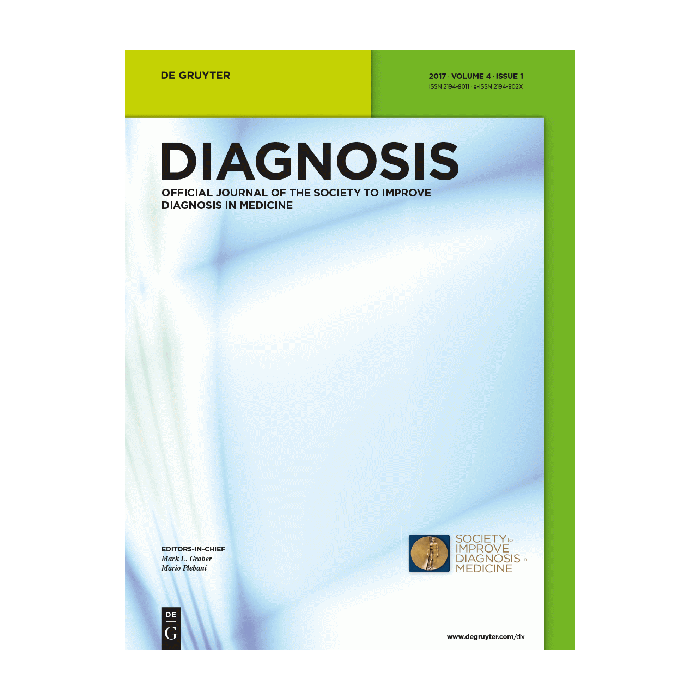Situativity: Diagnosis in the Real World
By Susan Carr | Senior Writer, ImproveDx
There appears to be no easy solution for the problem of diagnostic error. Efforts to improve system-related issues with diagnosis have made modest gains and are ongoing.1-3 Avoiding errors in clinical reasoning has been an elusive goal. Decades of study and reflection on the cognitive process have yielded greater understanding but no magic bullet to address diagnostic error.4,5
Situativity, a group of related theories based in cognitive psychology, offers another way to address diagnostic error by reframing how we understand the cognitive process. Emphasizing the social and complex nature of cognition, situativity takes an expansive view of factors that influence thinking and learning. Beyond recognizing that external forces can affect thinking, it sees the “dynamic and reciprocal interaction of the person, environment and behavior”6,7(p161) as a creative process.
A special, open access issue of Diagnosis explores different ways to apply situativity theory to teaching, improving and assessing diagnosis.
A Holistic Approach to Diagnosis
Applied to diagnosis, situativity explores what happens inside and outside the clinician’s head: medical knowledge plus the people, environment and interactions that surround and influence the process.8 “People” include, at a minimum, patients, family members and the clinician’s colleagues. The environment is the community and the healthcare setting, including all of what the setting offers (or doesn’t offer) in the way of infrastructure, technology and information. “Interactions” refers to connections and transactions not just between but among the forces that affect the ultimate outcome – in this case, diagnosis.
In an introduction to the situativity issue of Diagnosis, Co-Editor Mark L. Graber, MD, identifies three ways that situativity can impact the practice of diagnosis: it creates a more holistic view of contextual forces, offers alternatives for studying the diagnostic process and its outcomes, and emphasizes a broader set of interventions for improvement and error avoidance.9
Situativity’s Academic Roots
The term “situativity” traditionally refers to a unified understanding of four overlapping theories of cognition focused on different aspects of how people think in real situations:10
- Embodied cognition refers to the role of the human body and its systems of perception and motion. Sight, hearing, touch and smell all contribute information to clinical reasoning.
- Ecological psychology adds the idea that human participants bring varying levels of capability and motivation to each project. And on the other side of the equation, the inanimate players (eg, technology) offer opportunities to be used to achieve specific goals.
- Situated cognition includes all aspects of the environment – patients, colleagues, time pressures, technology, financial considerations, and more — and the interplay among these forces.
- Distributed cognition further acknowledges the role of collaboration – the contributions that people and things make, beyond simply inputting information to shaping the thought process.
The technical details and terminology of these “social cognitive” theories reflect situativity’s roots in academia. The particulars may be most relevant for cognitive scientists and researchers, but the concepts help reveal the richness and complexity of this approach.
Healthcare professionals do not need to be reminded that they work in a complicated, messy world. Situativity is a way to develop a deeper appreciation for the opportunities, challenges and barriers the healthcare ecosystem offers. That appreciation can help clinicians understand, use and influence people and things in their environment to improve diagnosis.
Other approaches to patient safety – sociotechnical systems, systems thinking, human factors engineering, and high reliability – also focus on elements of the environment. In its seminal 2015 report on improving diagnosis,11 the National Academy of Medicine stressed the importance of teamwork and feedback, technology, the work system and the physical and organizational environment. The situativity model adds another dimension by emphasizing the complex, nonlinear, evolving nature of the thinking and learning that takes place within real-world environments.
True collaboration involves learning from the give and take. In a process referred to as “emergence,” independent inputs to a process build on each other, leading to unexpected outcomes. In other words, the outcome is more than the sum of the parts. The game of Scrabble is often used to illustrate this concept, where individual letters offer different opportunities, each word spelled on the board lays the groundwork for what others may do, and the tiles themselves present a tactile experience that for some aids the thought process. The game evolves collaboratively over time, with the end result impossible to foresee.7,10
The effects of people, environment and interactions on diagnosis are, of course, not always positive or benign. Opaque electronic interfaces, language barriers, incommunicative colleagues, burnout and countless other challenge affect clinical reasoning, often in combination. Situativity can be used as a way to dissect or understand why things may have gone well or poorly.
Practical Applications
Situativity provides a new view of how we interact and think in the world; it does not provide a handy tool kit or cookbook solutions. Applying the model to medical practice has more to do with education, mentors and leadership than goal-oriented initiatives.
There are, however, articles in the special issue of Diagnosis that provide good examples of principles from the theory of situativity in action:
- In “Teamwork in clinical reasoning – cooperative or parallel play?”12 Andrew Olson, MD, and his co-authors discuss different kinds of teams used in health care and the advantages of teams working together at the level of emergence. To illustrate, they offer a scenario: A newly admitted patient describes her experience “…differently to the attending, resident, intern, student, and nurse. Each health care professional brings unique knowledge to the patient’s condition which they distribute among one another through conversation which leads to a shared mental model of a given situation.”12(p309) The resulting narrative is then entered into the patient’s record where it can be shared with other clinicians.
- In “Understanding context specificity: the effect of contextual factors on clinical reasoning,”13 Abigail Konopasky, PhD, and her co-authors report on a study of the effect of typical “distracting contextual factors” on resident and attending physicians. In what they describe as a robust experimental framework and a large sample of participants, they found that distracting contextual factors affected diagnosis for one case (angina) but not the other (diabetes). They determine that “…neither case content nor contextual factor is the sole predictor of clinical reasoning performance.”13(p262)
In a separate Diagnosis article, “Towards better metainterpretation: improving the clinicans’s interpretation of the radiology report,” Kevin M. Johnson, MD, urges referring clinicians to talk with radiologists for a better understanding of imaging studies. Johnson casts radiologists in the role of consultants, able to help add information, promote learning and prevent error. Referring to clinicians who rely solely on their own interpretation of a brief radiology report, without consulting the image itself or the radiologist, Johnson warns, “This road can be hazardous if traveled alone”14(p1) – a sentiment in keeping with the lessons of situativity.
And finally, a letter to the editor in the special issue of Diagnosis applies the situativity model to diagnostic challenges posed by the pandemic. In “Clinical reasoning in the wild: premature closure during the COVID-19 pandemic,”15 James G. Boyle, MD, and his co-authors develop a (fictionalized) scenario that includes a number of wrenches COVID-19 can throw into the works of the diagnostic process: redeployment to an unfamiliar setting and equipment, awkward personal-protective equipment, patient anxiety, and more. The authors note that COVID-19 “affords a unique opportunity to look beyond the mind of a single clinician and consider how an unprecedented constellation of contextual (situational) factors might impact clinical reasoning performance and lead to error.”15(p177)
Describing the scenario’s “ultimate message,”15(p178) they go on to say that diagnosis is “an ensemble process requiring collaboration with a diverse cast of actors and props who feature in an inherently complex sequence of narrative episodes.”15(p178) Another message from situativity is to not always cast complexity as a problem. There are times and circumstances, including the pandemic, when the complexity of the ensemble – acknowledging all of its risks – can be used to improve the diagnostic process and result, as well as the experience of those involved.
Thank you to our reviewers: Steven J. Durning, MD, PhD; Jeannine Cyr Gluck, MLS; Mark L. Graber, MD; Lorri Zipperer, MA.

In this Issue:
Situativity: A Family of Social Cognitive Theories for Clinical Reasoning and Error
A special, open access issue of Diagnosis explores different ways to apply situativity theory to teaching, improving and assessing diagnosis.

